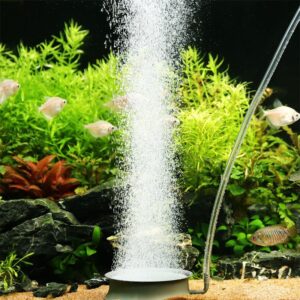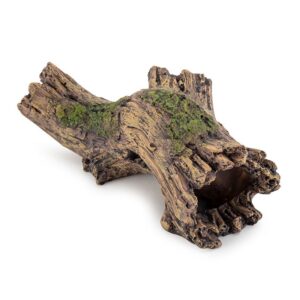Blackline tail tetra is a beautiful fish, and beauty reaches its peak when their school moves like a single unit. However, this Brazilian native needs to handle it properly. This article will address their profile, optimized water parameters, and how to maintain them. Moreover, a proper care sheet of blackline tail tetra is also part of learning. In the end, discussion about why they lose their tail fin and black spot on the tail of the tetra.
Content Table

Tetra with a black spot on the tail
Blackline Tail Tetra Profile
Blackline tail tetra is a schooling fish that brings diversity to any aquarium setup. Its vibrant coloration and beautiful breeding rituals make the scenery more interesting. These fish have a slender and elongated body with a slightly translucent hue.
Appearance and Moment
Blackline tail tetra has striking striped patterns, a black line that runs through the middle of the body, and a beautiful iris that enriches their beauty. Transparent fins with slightly colored at the end make them worth watching. The elegant swimming style adds more beauty to the tank.
Distribution and Habitat
These small fish are mainly distributed in the Brazilian, i.e., Itapicuru and San Francisco rivers, and South American regions. Usually, they live in shallow and vegetation-rich rivers and streams.
Here is a table to learn more about this blackline tail tetra:
| Scientific name | Moenkhausia cosmops |
| Family | Characidae |
| Common Name | Blackline Tail Tetra
Red-eye Moenkhausia |
| Distribution | Brazil and South America |
| Habitat | Shallow and vegetation-rich water distributaries |
| Size | 2.5 inches |
| Life span | Up to 5 years |
| Coloration | A dominant silver color with a black line runs through the center. |
| Behavior | Peaceful |
| Community | Social, live in a group of 6 to 8 |
| Preferred Swmining area | Middle to bottom of the tank |
| Food preference | Omnivorous |
| Substrate | Sand and fine gravel |
Why Does Blackline Tail Tetra Play Dead?
It’s due to stress, lack of acclimation and oxygen, and changes in water parameters. Frightening, disorientation and sudden environmental changes put the blackline tetras under stress. They play dead in new tanks or environments as a defense mechanism against these stress factors.
They also experience shock when water parameters, i.e., pH, water temperature hardness, etc., are out of the optimal range. The unexpected presence of chlorine traces in water also turns on their dead mode. Lack of oxygen and poor acclimation also make them lethargic in the new environment.
Optimal Water Parameters
Here are the optimal water parameters to make your tetra fish healthy and active.
| Feature | Value |
| Temperature | 72-82°F |
| pH | 6.0-7.5 |
| Water hardness | 4-12 dGH |
| Breeding difficulty | Moderate |
| Nitrates | 20ppm |
| Ammonia | 0 |
| Nitrite | 0 |
| Chlorine | 0 |
Maintaining the Optimal Water Quality
With these methods, You can avoid Blackline Tail Tetra playing dead in the new tank setup.
| Be consistent with water parameters | Regularly change 20 to 30% per week | Use air stone and filter to improve the water aeration |

Care sheet of blackline tail tetra
Care Sheet of Blackline Tail Tetra
It’s easy to take care of blackline tail tetras. Here are the different aspects that require optimization.
Tank Setup
A small group, i.e., 6 to 8 blackline tail tetras, requires at least a 20-gallon tank. If you want a big school, keep on adding the tank size. Lay an up to 2-inch deep layer of gravel or sand of substrate. Their natural habitat is full of vegetation. Therefore, grow live plants, i.e., java fern, anubias, and Amazon swords, to feel them at home. Along with plants, install aquarium driftwood and rocks into the tank. Use a filter that doesn’t produce strong currents.
Lighting
They require moderate lighting, as intense lighting causes stress among them. Moreover, dim lighting reduces stress and makes their color more vibrant. Set a proper day-night cycle and grow a few floating plants in the tank to reduce the light intensity.
Diet
Blackline tail tetras are omnivorous. You can feed them on high-quality pellets and live and frozen food items, i.e., brine shrimps, daphnia, bloodworms, etc. Blanched spinach and peas are the vegetative options, along with flakes. Feed them 2 to 3 times a day. Give only the dose that they finish within 30 seconds, and keep a variation in their diet.
Tank Mates
You can keep them in a community fish tank. The most suitable tank mates include neon tetras, rasboras, corydoras, and dwarf gouramis. You can also keep other fish. However, never keep them with large and aggressive fish. They can bully and harm them.
Health Issues
Blackline tail tetra can face different health issues. It includes
| Ich | Bacterial infections | Fungal infections |
| Dropsy | Fin/tail rot | Swim bladder disorders |
| Parasites | Pop eye | Belly or bloat |
However, they are more susceptible to Ich, fin rot, and bacterial infection. To avoid these issues, maintain the optimal water parameters, avoid overfeeding, and do a regular inspection. Never quarantine the new fish before adding them to the old tank. Keep the water circulation and filtration at optimal levels.
Breeding
Blackline tail tetras have a mid-level breeding difficulty. Set the following parameters in the breeding tank.
| pH: 6.0–6.5 | Grow live plants | Soft water |
Male tetra and female tetra do a courtship. After courtship, the female lays eggs in clutches, and the male fertilizes the eggs. After fertilization, remove the pair from the breeding tank to avoid cannibalism.
Change the water up to 50% and cover the tank. Eggs usually take 36 hours to hatch. However, continually inspect the eggs during this duration. If you see fungus or milky white, the eggs will not hatch. If eggs are black, the embryo has developed. On hatching, you can see transparent fry.

A school of blackline tail tetra
A School of Blackline Tail Tetra
A minimum 75 L or 20-gallon tank is suitable for a group of 6 or more blackline tail tetras. 6 is the baseline for them. Otherwise, they will go into stress, play dead, and be vulnerable to different diseases.
Interesting Facts of Schooling Tetra Fish
As you increase the group size,
- They show vibrant coloration, especially a distinctive black line and vibrant red eyes.
- Feel a sense of protection from predators.
- They exhibit a coordinated swimming pattern and turn and shift as a unit.
- They build social dynamics and communicate with body movements, subtle color-changing, and positioning in the group.
- It improves their health and reduces stress.
- They increase their activity and explore each corner of the tank.
- Breeding improves with the size of the group.
Blackline Tail Tetra Missing Part of Tail Fin
The tail fin is one of the most beautiful parts of blackline tail tetras. Sometimes, you find it missing or a black spot on the tail. It dilutes the beauty. There are several reasons for missing. In the following, you’ll find causes and cures.
Fin Rot
| Cause | Cure |
| Fin rot is a common bacterial and fungal infection among blackline tail tetras. It often starts due to poor water quality, injury, or stress. It begins minutely and gradually gets worse and causes loss of the tail fin. | Optimize the water parameter. Quarantine the fish Use antibacterial or antifungal medication, i.e., Melafix and Pimafix |
Vitamin Deficiencies
| Cause | Cure |
| A poor diet lacks vitamins. If you feed your blackline tail tetra, you will observe a vitamin deficiency that results in weak fins. In this way, they are prone to damage and increase the healing time. | Feed varying quality diets, i.e., high-quality flakes, pellets, brine shrimps, bloodworm, etc. |
Injury or Trauma
| Cause | Cure |
| Collision with sharp edges of hard scapes and rough substrate can also cause the loss of the tail fin in blackline tail tetra. | Smooth the sharp edges Smooth the rough substrate |
Fin Nipping
| Cause | Cure |
| Sometimes, aggressive tank mates damage the tail fin. | Avoid stocking with fin-nipping species. Keep blackline tail tetra in large groups. Grow live plants as they provide shelter. |
Tetra With Black Spot on Tail
It’s also known as black spot disease or black ich. A tetra with a black spot on the tail usually appears as a tiny, raised black dot approximately up to the size of a salt grain.
| Cause | Cure |
| A parasitic infection, i.e., Praziquantel, caused it. | It’s harmless and cured over time. Vacuum the substrate Quarantine the affected fish Dip in freshwater and then into formalin |

Take care of blackline tail tetra
In Closing
Blackline tail tetras are sliver-hued, beautiful, and mainly Brazilian fish. These carnivores live in slightly acidic water conditions, especially during breeding. Tank setup requires growing live plants, installing medium lights, and diet variation. Maintain a school of 6 or more. Sometimes, the blackline tail tetra loses its tail fin for various reasons. Take a reference to the care sheet in the article and take proper measures to recover them.


I congratulate, your opinion is useful